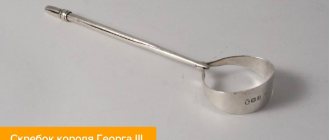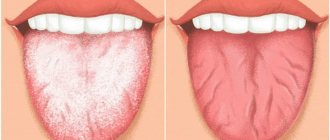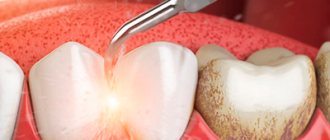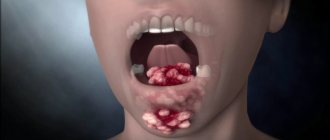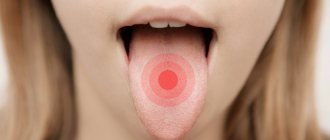People have long been accustomed to brushing their teeth every day. But not everyone knows that it is necessary to take care of the entire oral cavity, since this place is considered a breeding ground for bacteria and microbes. Most of them accumulate on the tongue. That's why caring for it is so important. To effectively remove plaque from the taste organ, you will need a tongue brush.
The tongue is a muscular organ involved in chewing, salivation, voice production and taste perception of food. In medicine, it is customary to roughly divide an organ into three parts: the root (base), body and apex (tip). The surface of the tongue is uneven due to the papillae covering it - taste buds. A healthy organ is pink in color, and the appearance of a light gray thin coating on it in the morning or after eating is considered normal. Typically, formations accumulate at the root of the tongue, since its tip is more mobile and, as a result, self-cleanses.
Consequences of poor tongue hygiene
The plaque on the organ of taste consists of off-white deposits.
Usually these are food debris, saliva, epithelial particles, and microorganisms. Due to the rough structure of the surface of the tongue, formations that accumulate there are difficult to remove with regular rinsing. This creates a favorable environment for the proliferation of pathogenic microorganisms. The result is that inflammatory processes occur in the oral cavity.
Examples of pathologies include gingivitis, stomatitis, glossitis, and periodontal disease. Plaque that is not removed in time causes bad breath and also contributes to the formation of tartar and caries. Deposits, hiding taste buds, do not allow a person to enjoy the process of eating.
Benefits of tongue cleaning
Scientists have found that halitosis (bad breath) appears due to the bacteria solobacterium moorei . Examining the oral cavity of volunteers, the bacteria solobacterium moorei were found in 100% of people suffering from halitosis and in 14% of those who did not suffer from it.
Solobacterium moorei is responsible for the formation of foul odors - as a result of the production of hydrogen sulfide, indole and skatole. All volunteers in the experiments who were found to have solobacterium moorei also had periodontitis (gum infection), plus diseases of the lungs and paranasal sinuses often accompany halitosis.
Regular tongue cleaning will reduce the number of harmful bacteria in the oral cavity and reduce the risk of developing dental plaque by 33%. Bad breath goes away after brushing your tongue in 85% of cases, while after brushing your teeth it goes away in only 25% of cases.
Regular tongue cleaning:
- reduces the number of pathogenic bacteria in the oral cavity by 10 times;
- will reduce the risk of developing dental plaque by 33%;
- helps get rid of halitosis – bad breath in 85% of cases;
- helps enrich taste sensations;
- helps activate and stimulate the functioning of internal organs - through massage of the tongue receptors.
The tongue must be cleaned every day, regardless of whether plaque appears on it or not. Everyone, without exception, needs to clean it, especially smokers and people with a “geographical” tongue.
Geographic tongue (desquamative glossitis) is an inflammatory condition of the tongue, affecting approximately 2% of the population.
What is a tongue brush?
The scraper brush consists of an elastic plastic handle ending with a round, flat tip. Thanks to this configuration of the device, people cleaning their tongues do not have a gag reflex, as when using a toothbrush. On its working surface, unlike a simple scraper, there are small bristles. On the instruments of some companies, in addition to the bristles, there are plastic or silicone strips on the other side. Hygienic products are sold in pharmacies, specialized retail outlets or online stores.
How to use?
The procedure is performed after brushing your teeth and rinsing your mouth with water twice a day for one minute.
To do this, you need to use a brush with light sweeping movements from the base of the tongue to the tip, cleaning first one half of it, then the other.
Then you should change the stroke of the tool from longitudinal to transverse, moving in the same direction.
After each such manipulation, it is recommended to rinse the item with clean water in order to wash away the plaque that has stuck to it.
When cleaning, you can use antibacterial paste or powder, but not with abrasive particles, so as not to damage the delicate tissue of the organ. The procedure ends with rinsing the mouth followed by the use of an antiseptic gel. This is necessary to eliminate any remaining germs. After each cleaning session, the scraper brush must be washed with soap and rinsed with warm water. It is recommended to change the device every three months, like a regular toothbrush.
When cleaning, you should not press hard on the hygiene instrument, as pressure may damage the muscular part of the organ.
Which tongue scraper should I buy?
Dentists do not recommend using toothbrushes to clean the surface of the organ. Because they are inconvenient to use and cause a gag reflex, which scares many people away. Therefore, there is an alternative option - a scraper. The market for oral care devices is vast; hygiene instruments of a wide variety of types, colors and materials are found on the shelves.
Before purchasing a brush-scraper, it is recommended to consult a dentist. The doctor will assess the condition of the tongue and identify possible pathologies. For example, if a fungus or diseases of the gastrointestinal tract are discovered, then it is difficult to get rid of plaque with a scraper; you can only damage the papillae. And with stomatitis and glossitis, cleansing is generally prohibited.
Jordan Tongue Cleaner
When choosing the “right” scraper, you should visually determine the size of the surface of the tongue. If the device is larger, then due to frequent friction the gums, teeth or the organ itself may suffer. If it is less, the tongue will not be cleaned well. It is also important that the hygiene instrument does not touch the soft palate, since pressure on it can cause gagging.
If the device is made of plastic and rubber, then it will have a gentle effect. But then it is worth changing the tool more often - a maximum of once every three months, since invisible plaque particles accumulate on its surface with each use. Subsequently, if the scraper is not replaced on time, deposits on it can enter the oral cavity and provoke the development of dental diseases.
Cleaning devices made from stainless steel, silver or copper will last longer than their counterparts, but their price will be higher. Experts advise boiling such an instrument or sterilizing it before first use.
Curaprox
Available in the form of a set that includes two scrapers: narrow and wide. The first has one cleaning surface for delicate removal of plaque from the tongue. The second has two active “blades”. One, smooth, is designed for more thorough cleaning of the root of the organ and large accumulations of bacteria. The other, serrated, removes plaque from the front of the tongue. The anatomical shape of the instruments prevents the gag reflex. Hygienic devices are made of low-allergenic plastic.
Сuraprox hygiene products
Trisa
The scraper has delicate active cleaning edges on both sides: hard and soft. Using the first, plastic, stubborn plaque is removed from the surface of the organ. The second, rubber, massages the tongue.
Miradent
At the top of the scraper, which resembles a spoon, there are short bristles and a plastic arc that gently remove plaque. The base of the device is slightly tilted forward, 175 degrees, which allows for better tongue cleaning.
Meridol Halitosis
The base of the tool consists of 2 parts. On the top there are two rows of short rubber bristles. There are four strips of plastic scrapers on the bottom. The brush-scraper not only cleanses the tongue of plaque, but also massages the areas that are reflexively connected with the internal organs.
"Freshness"
On the working part of the tool there are two curved plastic scrapers. A sharp “blade” cleans the surface of the tongue from large deposits. And the relief one is intended for massage and thorough cleaning between the papillae.
Why is cleaning your tongue so important for your health?
The digestive system of the human body does not stop working even at night. When we sleep, many important processes occur, including the release of dangerous toxins into the oral cavity. This is why it is so important, after waking up, not only to brush your teeth, but also the surface of your tongue, on which toxic breakdown products of the food we ate the day before accumulate.
Toxins can cause many diseases and also have detrimental effects on the immune, respiratory and digestive systems. As a result of a series of studies, scientists have concluded that a specialized tongue scraper is much better at removing harmful compounds than a regular toothbrush, which removes only part of the potentially dangerous plaque.
The surface of the tongue is extremely heterogeneous and is dotted with grooves, grooves and microspaces. Pathogenic microorganisms “hide” precisely in the deep fissures of the tongue, which are not so easy to reach. There, simply ideal conditions for reproduction have been created for them - humid, warm, and light does not penetrate there.
Therefore, a special tool is required that can not only remove visible (white, green) plaque, but also bacteria invisible to the eye. It is important to note that the oral cavity always contains normal and conditionally pathogenic flora, i.e. microorganisms that do not cause harm. However, when the immune system , opportunistic bacteria very quickly transform into staphylococci, streptococci and others that are truly dangerous to health.
According to statistics, people who clean their tongues of plaque on a regular basis are ten times less likely to suffer from diseases such as:
- Caries is a sluggish pathological process in which demineralization of enamel occurs and destruction of its matrix, which ultimately leads to the formation of cavities in dentin (hard tooth tissue), as well as the occurrence of periodontitis and pulpitis .
- Gingivitis is an inflammation of the gums that does not damage the integrity of the periodontal junction. It is considered the initial stage of periodontitis .
- Stomatitis is a lesion of the oral mucosa, which is caused by a number of diseases of the gastrointestinal tract (hereinafter referred to as the gastrointestinal tract) or improper oral hygiene.
- Glossitis is an inflammatory process that occurs under the influence of pathogenic flora or injury to the tongue.
- Halitosis or bad breath.
Reviews
Fedor, 45: “I’ve been using this simple device for five years now. The doctor recommended buying a scraper, since I had never used it before, but only cleaned my teeth. The plaque gradually accumulated on the tongue, and eventually he contracted a disease, from which it took him a long time to get rid of it. Now I use this tool regularly. I noticed that my taste buds began to work better, and the lack of bad breath is another bonus.”
Anna, 24: “I have nothing against scrapers on toothbrushes, but they cause vomiting. I decided to try a more gentle product that would clean the tongue well and not cause any discomfort. I consulted with a doctor, he drew attention to a special brush. The rubber coating almost instantly removes plaque accumulated over the day or night. But most importantly, the procedure is quick and easy.”
Kostya, 37: “On the back of many toothbrushes there are tongue scrapers. Using my own example, I was convinced that not everyone copes with this function or does not act at all. The doctor advised me to purchase a Curaprox scraper. I have been using devices from this company for two years now. The tongue is cleaned quickly and there is no bad breath. There is no gag reflex, as was the case with the brush. I advise my friends to buy this product."
Oral care is one of the important procedures, and a brush-scraper will become an indispensable tool in removing bacterial plaque. To protect the body from viruses and infections, you should attach special importance to brushing not only your teeth, but also your tongue.
How to clean your tongue?
You should begin the tongue cleaning procedure after brushing your teeth. Proper tongue cleaning starts from the root towards the tip. With gentle pressure, you need to move from the root to the tip of the tongue several times (you can use a small amount of toothpaste). Then treat the side surfaces of the tongue on the left and right in the same way. Finally, gently cleanse the inside of your cheeks and then rinse your mouth with water. After this, oral care can be considered complete.
In total, the entire tongue cleaning procedure will take from one to several minutes. That is, literally in a matter of minutes you will be able to eliminate bad breath and prevent a number of diseases. As you know, prevention is always more pleasant and cheaper than treatment. Therefore, it is worth making tongue cleansing a healthy habit and doing it every time after brushing your teeth. In the evenings, rinse your mouth with mouthwash . It will help kill any remaining bacteria after scrubbing or brushing.
Remember: hygiene and prevention are the best cure!
Quantity
